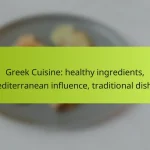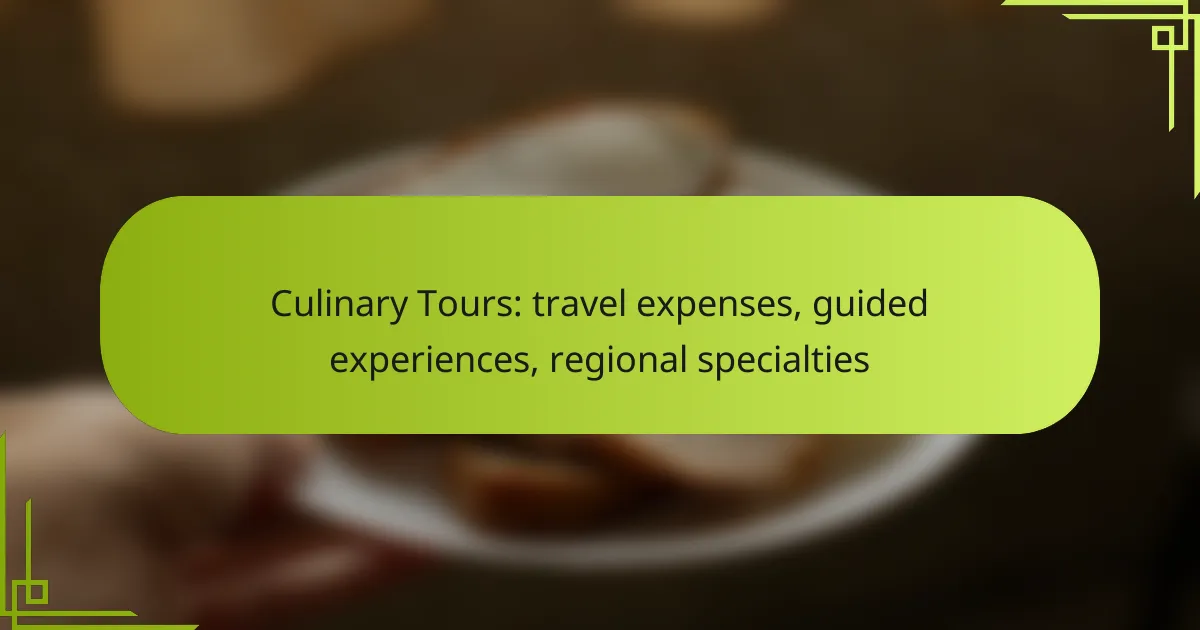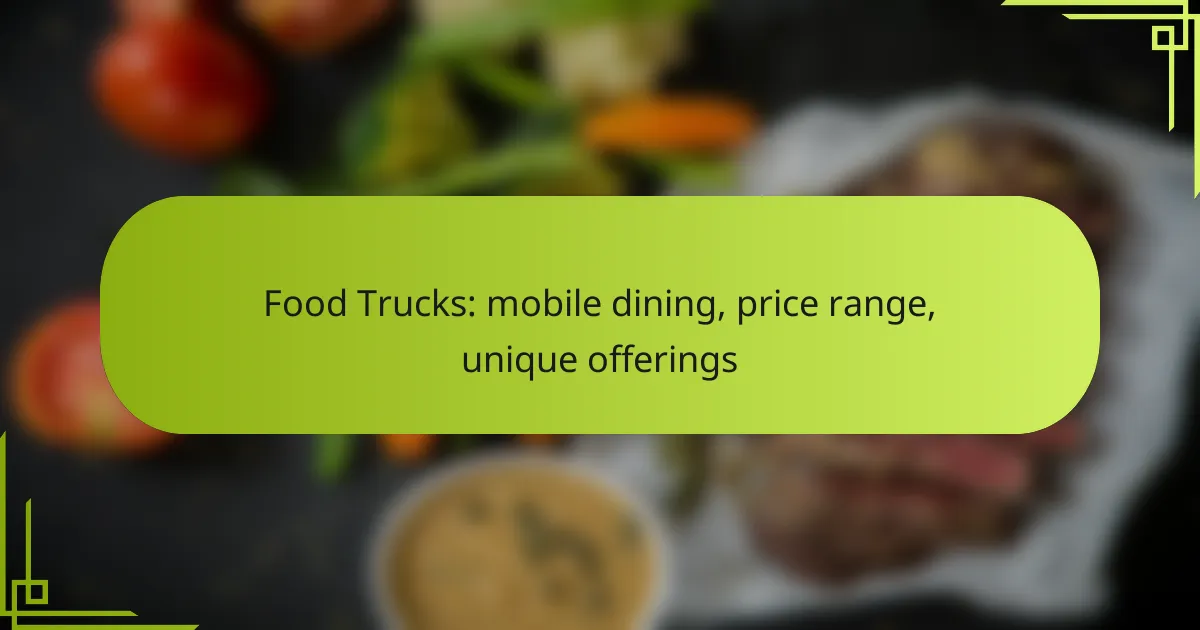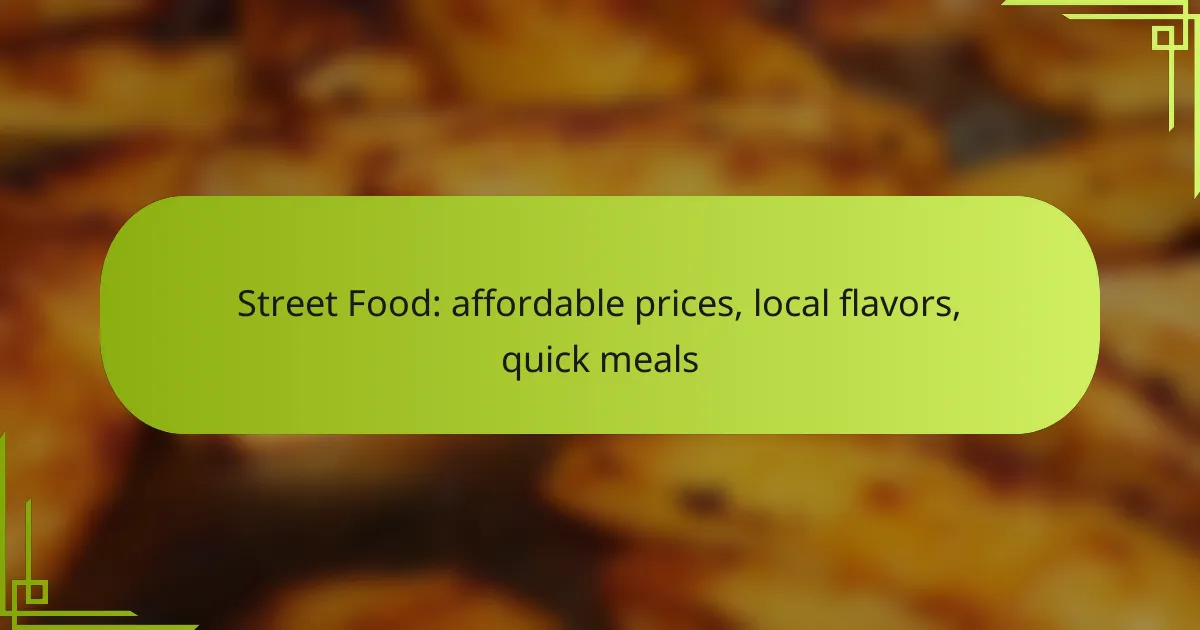Culinary tours provide an exciting way to discover regional specialties while enjoying guided experiences that highlight local culture and ingredients. From vibrant food festivals to intimate tastings at hidden gems, these tours immerse travelers in the authentic flavors of their destinations. Prices for these experiences can vary widely, influenced by factors such as location, duration, and group size.

What are the best culinary tours in Canada?
The best culinary tours in Canada offer a unique opportunity to explore regional specialties while enjoying guided experiences. These tours typically include tastings at local restaurants, markets, and food festivals, allowing travelers to savor authentic Canadian cuisine.
Foodie Tours in Toronto
Toronto’s foodie tours showcase the city’s diverse culinary landscape, featuring everything from international cuisines to local delicacies. Popular options include the Kensington Market food tour, where visitors can sample artisanal cheeses, fresh produce, and ethnic street food.
When considering a foodie tour in Toronto, look for experiences that include a variety of tastings and knowledgeable guides. Prices generally range from CAD 50 to CAD 150 per person, depending on the length and inclusions of the tour.
Vancouver Culinary Experiences
Vancouver offers culinary experiences that highlight its fresh seafood and farm-to-table dining. Tours such as the Granville Island Market tour allow participants to taste local specialties, including sushi, artisanal pastries, and gourmet cheeses.
For a memorable experience, opt for tours that combine food tastings with scenic views, such as those along the waterfront. Expect to pay between CAD 75 and CAD 200, depending on the tour’s duration and the number of tastings included.
Montreal Gourmet Tours
Montreal’s gourmet tours focus on its rich culinary heritage, featuring iconic dishes like poutine and bagels. The Old Montreal food tour is a favorite, offering tastings at historic eateries and local markets.
When choosing a gourmet tour in Montreal, consider those that provide a mix of food history and tastings. Prices typically range from CAD 60 to CAD 180, with options for both group and private tours available.

How much do culinary tours cost in Canada?
Culinary tours in Canada typically range from a few hundred to over a thousand Canadian dollars, depending on the length and inclusivity of the experience. Prices can vary significantly based on the region, type of cuisine, and whether the tour is private or group-based.
Average tour prices
On average, a half-day culinary tour may cost between CAD 100 to CAD 200 per person, while full-day experiences can range from CAD 200 to CAD 500. Premium tours that include exclusive tastings or private chefs can exceed CAD 1,000.
For example, a guided tour in major cities like Toronto or Vancouver may be on the higher end of the spectrum due to the cost of living and demand for unique culinary experiences.
Factors affecting costs
Several factors influence the cost of culinary tours in Canada, including the location, duration, and the number of included meals or tastings. Tours in popular tourist destinations or regions known for specific cuisines often charge more.
The type of experience also matters; private tours are generally more expensive than group tours. Additionally, seasonal variations can affect pricing, with peak tourist seasons typically seeing higher rates.
Budget-friendly options
For those looking to enjoy culinary experiences without breaking the bank, consider joining group tours or opting for half-day experiences. Many cities offer affordable walking food tours that highlight local specialties at a lower price point, often around CAD 50 to CAD 100.
Another option is to explore local markets or food festivals, which can provide a taste of regional cuisine without the cost of a formal tour. Researching online for discounts or package deals can also yield budget-friendly opportunities.

What regional specialties can you taste on culinary tours?
Culinary tours offer a unique opportunity to savor regional specialties that reflect local culture and ingredients. From fresh seafood to hearty comfort foods, these tours showcase the diverse flavors that define each area.
Pacific Northwest seafood
The Pacific Northwest is renowned for its abundant seafood, including salmon, halibut, and Dungeness crab. Culinary tours in this region often include visits to local fisheries and markets, where you can sample fresh catches prepared in traditional ways.
When participating in these tours, consider trying dishes like cedar-plank salmon or clam chowder. Many tours also offer cooking classes, allowing you to learn how to prepare these specialties yourself.
Quebecois poutine
Poutine, a beloved dish from Quebec, consists of fries topped with cheese curds and smothered in gravy. Culinary tours in Quebec often feature this comfort food, highlighting variations that include additional toppings like pulled pork or sautéed mushrooms.
To fully enjoy poutine, seek out local diners or food trucks known for their unique takes on this dish. Pairing it with a local craft beer can enhance the experience.
Prairie farm-to-table dishes
The Prairie region emphasizes farm-to-table dining, showcasing ingredients sourced directly from local farms. Culinary tours here often include visits to farms, where you can learn about sustainable practices and taste seasonal produce.
Look for dishes that highlight grains, meats, and vegetables unique to the area, such as bison burgers or heirloom tomato salads. Participating in farm tours can provide insight into the local agricultural landscape and enhance your culinary experience.

What are the benefits of guided culinary experiences?
Guided culinary experiences offer travelers unique advantages, including expert knowledge and access to local flavors. These experiences enhance your understanding of regional cuisines while providing opportunities for social interaction and exclusive dining.
Expert local insights
Guided culinary tours connect you with local chefs and food artisans who share their expertise and stories. This insider knowledge enriches your culinary journey, allowing you to learn about traditional cooking methods, local ingredients, and cultural significance behind dishes.
For example, a tour in Italy might include a pasta-making class with a nonna, where you not only learn techniques but also hear about family recipes passed down through generations. Such experiences deepen your appreciation for the cuisine and its history.
Access to exclusive venues
Many guided culinary experiences provide access to venues that are not open to the general public. This could include private kitchens, specialty markets, or renowned restaurants where reservations are difficult to secure.
In cities like Paris, a culinary tour might take you to a hidden bistro known only to locals, offering a unique tasting menu that showcases seasonal ingredients. This exclusivity enhances the overall experience and allows for memorable dining moments.
Social dining opportunities
Participating in guided culinary experiences often means sharing meals with fellow food enthusiasts. This social aspect can lead to new friendships and shared stories, making the dining experience more enjoyable and engaging.
Consider joining a group cooking class where participants collaborate to prepare a meal. This not only fosters camaraderie but also allows for the exchange of culinary tips and cultural insights, creating a richer experience for everyone involved.

How to choose the right culinary tour?
To choose the right culinary tour, consider factors such as the duration, itinerary, group size, and reviews. These elements will help ensure that the experience aligns with your interests and expectations.
Tour duration and itinerary
When selecting a culinary tour, evaluate the duration and itinerary to ensure it fits your schedule and culinary interests. Tours typically range from a few hours to several days, offering various experiences from cooking classes to multi-stop food tastings.
For example, a half-day tour might focus on street food in a city, while a week-long tour could explore regional cuisines across multiple locations. Consider what you want to achieve: a deep dive into one cuisine or a broader overview of several.
Group size and experience level
The size of the group can significantly impact your culinary tour experience. Smaller groups often allow for more personalized attention and interaction with guides, while larger groups may offer a more social atmosphere but less individual engagement.
Additionally, consider the experience level of the tour. Some tours cater to beginners, while others may require a certain level of culinary knowledge. Choose a tour that matches your comfort level to enhance your enjoyment and learning.
Reviews and recommendations
Reading reviews and seeking recommendations is crucial when choosing a culinary tour. Look for feedback on platforms like travel websites or social media to gauge the quality of the experience.
Pay attention to comments about the food quality, guide expertise, and overall satisfaction. Recommendations from friends or travel bloggers can also provide valuable insights, helping you avoid tours that may not meet your expectations.










